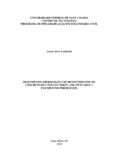| dc.creator | Lamberti, Lucas Alves | |
| dc.date.accessioned | 2021-08-03T18:27:43Z | |
| dc.date.available | 2021-08-03T18:27:43Z | |
| dc.date.issued | 2019-12-06 | |
| dc.identifier.uri | http://repositorio.ufsm.br/handle/1/21710 | |
| dc.description.abstract | The urbanization, associated with the population growth, is responsible for waterproofing surfaces, which increases inundation events frequency. To ease these problems, among other actions, come permeable pavements. This pavement is based on reduction of the surface runoff volume by allowing infiltration and storage of the water in its structure, and after that, the infiltration into the local soil. The objective of this work is to evaluate the structural and hydraulic performance of different permeable pavements to be built in the subtropical region of Brazil (Santa Maria-RS). We evaluated over the same structure, pervious concrete, pervious concrete pavers, concrete pavers and grass paver. Firstly, a laboratory investigation was carried out of the mechanical, hydraulic and durability characteristics of permeable concrete caused by differences in aggregate composition (unit mixture) in the mixture. Considering the best unit mixture, 1m² experimental modules were constructed to verify the effect of pore fouling over time, and then, parking lots to analyze the hydraulic efficiency of the permeable pavements under real conditions. It was concluded that the addition of 5% of sand and gravel combination between the 4.75/12.5mm and 9.5/25mm sieves in the permeable concrete provides a desirable gain of mechanical strength although it reduces the water percolation capacity. There was also a great heterogeneity in the value of the permeable concrete voids index implemented in the experiments when compared to the investigated in the laboratory, attributed to the workability of the mixture. Regarding the effect of sediment on the clogging, it was identified that those with higher grain size, such as sand, reduce the efficiency of permeable concrete more than materials with smaller grain size, such as clay, and that high pressure washing is able to recover floor efficiency. It was also observed that, among the analyzed coatings, the floors with permeable concrete, pervious concrete pavers and grass paver had similar hydrological performance. | eng |
| dc.language | por | por |
| dc.publisher | Universidade Federal de Santa Maria | por |
| dc.rights | Attribution-NonCommercial-NoDerivatives 4.0 International | * |
| dc.rights.uri | http://creativecommons.org/licenses/by-nc-nd/4.0/ | * |
| dc.subject | Pavimento permeável | por |
| dc.subject | Concreto permeável | por |
| dc.subject | Escoamento superficial | por |
| dc.subject | Permeable pavement | eng |
| dc.subject | Pervious concrete | eng |
| dc.subject | Surface runoff | eng |
| dc.title | Desempenho hidrológico de revestimentos de concreto de cimento Portland aplicados a pavimentos permeáveis | por |
| dc.title.alternative | Hydrological performance of Portland cement concrete coatings applied to permeable pavements | eng |
| dc.type | Tese | por |
| dc.description.resumo | A urbanização, associada ao crescimento populacional, é responsável pela impermeabilização das superfícies, que, pela sua vez, aumenta a frequência de inundações. Na atenuação desses problemas surgem, entre outras medidas, os pavimentos permeáveis. Este tipo de pavimento reduz o volume de escoamento superficial ao permitir a infiltração e armazenamento da água em sua estrutura e, em seguida, no solo local. O presente trabalho teve por objetivo avaliar o desempenho de diferentes tipos de pavimentos permeáveis construídos na região subtropical do Brasil (Santa Maria – RS). Foram analisados sobre a mesma estrutura revestimentos de concreto permeável, intertravado de concreto permeável e convencional e blocos pisograma. Primeiramente, fez-se uma investigação em laboratório das características mecânicas, hidráulicas e de durabilidade do concreto permeável provocadas por diferenças na composição do agregado (traço) na mistura. Considerando os melhores traços, foram construídos módulos experimentais a escala com 1m² cada para verificar o efeito da colmatação (entupimento dos poros) dos sistemas ao longo do tempo e, na sequência, vagas de estacionamento para analisar a eficiência hidráulica dos pavimentos permeáveis em condições reais. Concluiu-se que a inserção de 5% de areia e combinação de britas entre as peneiras 4,75/12,5mm e 9,5/25mm no concreto permeável proporciona ganho desejável de resistência mecânica embora reduza a capacidade de percolação d’água. Foi verificada ainda uma grande heterogeneidade no valor do índice de vazios do concreto permeável implementado nos experimentos quando comparado ao investigado em laboratório, atribuída à trabalhabilidade da mistura. Quanto ao efeito de sedimentos na colmatação dos poros do concreto, foi identificado que os de maior granulometria, tais como areia, reduzem mais a eficiência do concreto permeável do que materiais de menor granulometria, como a argila, e que, lavagem sob alta pressão é capaz de recuperar totalmente a eficiência dos pavimentos. Observou-se ainda que, dentre os revestimentos analisados, os pavimentos com concreto permeável, intertravado de concreto permeável e blocos pisograma tiveram desempenho hidrológico semelhante. | por |
| dc.contributor.advisor1 | Piccilli, Daniel Gustavo Allasia | |
| dc.contributor.advisor1Lattes | http://lattes.cnpq.br/3858010328968944 | por |
| dc.contributor.advisor-co1 | Cervo, Tatiana Cureau | |
| dc.contributor.referee1 | Giacomoni, Márcio Hofheinz | |
| dc.contributor.referee2 | Dornelles, Fernando | |
| dc.contributor.referee3 | Padillo, Alejandro Ruiz | |
| dc.contributor.referee4 | Pereira, Deividi da Silva | |
| dc.creator.Lattes | http://lattes.cnpq.br/3949665856490989 | por |
| dc.publisher.country | Brasil | por |
| dc.publisher.department | Engenharia Civil | por |
| dc.publisher.initials | UFSM | por |
| dc.publisher.program | Programa de Pós-Graduação em Engenharia Civil | por |
| dc.subject.cnpq | CNPQ::ENGENHARIAS::ENGENHARIA CIVIL | por |
| dc.publisher.unidade | Centro de Tecnologia | por |



